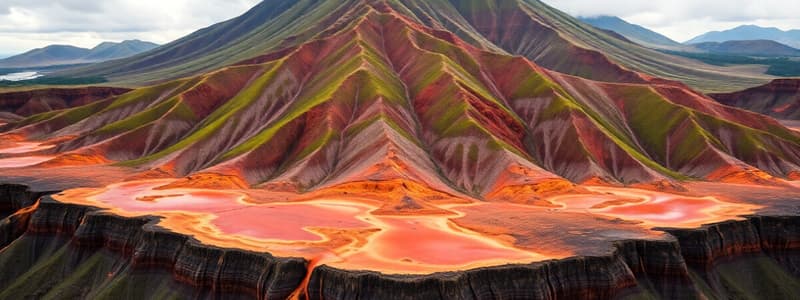Podcast
Questions and Answers
What is the average geothermal gradient in the upper 100 km of the Earth's crust?
What is the average geothermal gradient in the upper 100 km of the Earth's crust?
- 30°C per kilometer
- 25°C per kilometer (correct)
- 20°C per kilometer
- 15°C per kilometer
What constitutes an interplate volcano?
What constitutes an interplate volcano?
- Volcanoes created by hydraulic fracturing processes
- Volcanoes situated at active plate boundaries (correct)
- Volcanoes formed from hotspot activity away from plate edges
- Volcanoes located at the center of tectonic plates
Which type of rock primarily forms from volcanic eruptions at mid-ocean ridges?
Which type of rock primarily forms from volcanic eruptions at mid-ocean ridges?
- Rhyolite
- Basalt (correct)
- Granite
- Obsidian
What is a characteristic feature of pillow basalts formed from underwater eruptions?
What is a characteristic feature of pillow basalts formed from underwater eruptions?
Which of the following is NOT a likely feature of intraplate volcanoes?
Which of the following is NOT a likely feature of intraplate volcanoes?
Study Notes
Geothermal Gradient
- The Earth's internal heat comes from residual heat left over from formation and ongoing radioactive decay.
- Geothermal gradient is the rate at which temperature increases with depth.
- The average geothermal gradient in the upper 100 km of Earth's crust is about 25°C per kilometer of depth.
Volcanism
- Lava is molten rock that emerges onto the Earth's surface.
- Volcanoes are land formations created when lava solidifies into rock.
Distribution and Tectonics
- Most volcanoes are interplate volcanoes located at active plate boundaries (mid-ocean ridges, subduction zones, and continental rifts).
- Intraplate volcanoes are located within tectonic plates, far removed from plate boundaries.
- Many intraplate volcanoes are formed by hotspots.
Volcanoes at Mid-ocean Ridges
- Most volcanism on Earth occurs on the ocean floor along mid-ocean ridges.
- The least observed volcanoes are located under 3,000-4,500 m of ocean.
- The diverging plates allow hot mantle rock to rise, causing decompression melting.
- Ultramafic mantle rock (peridotite) partially melts and generates basaltic magma.
- Pillow basalts are structures formed when basaltic lava erupts underwater.
- Deep-sea hydrothermal vents (black smokers) are tall vents emitting black, hot mineral-rich water.
Volcanoes at Subduction Zones
- Subduction zones are a type of convergent plate boundary where the second most common volcanism occurs.
- Subduction expels water from hydrated minerals in the descending slab, causing flux melting in the overlying mantle rock.
- The Ring of Fire surrounding the Pacific Ocean is dominated by subduction-generated eruptions of mostly silica-rich lava.
Volcanoes at Continental Rifts
- Continental rifts are created by diverging lithospheric plates.
- Crustal thinning caused by diverging plates results in basaltic lava eruptions such as flood basalts, cinder cones, and basaltic lava flows.
Hotspots
- Hotspots are the main source of intraplate volcanism.
- Hotspots occur when lithospheric plates glide over a hot mantle plume.
- Mantle plumes generate melts as material rises, with magma rising even more.
- When the ascending magma reaches the lithospheric crust, it spreads out into a mushroom-shaped head.
- Hotspot volcanism under an oceanic plate can create islands like the Hawaiian Islands.
- Hotspots under continental plates can create intermediate magma by mixing mafic and felsic material.
Volcano Features and Types
- Volcanoes are classified based on shape, eruption style, magmatic composition, and other aspects.
- Stratovolcano (composite cone volcano): has steep flanks, a symmetrical cone shape, distinct crater, and rises prominently above the surrounding landscape.
- Shield Volcano: characterized by broad, low-angle flanks, small vents at the top, and mafic magma chambers.
- Cinder Cone: small volcanoes with steep sides, made of pyroclastic fragments ejected from a central vent.
- Lava Domes: accumulations of silica-rich volcanic rock, such as rhyolite and obsidian.
- Caldera: steep-walled, basin-shaped depressions formed by the collapse of a volcanic edifice into an empty magma chamber.
- Flood Basalts: massive eruptions of low viscosity basaltic lava, not observed in modern times.
Volcanic Hazards and Monitoring
- Volcanic hazards include lava flows, pyroclastic flows, lahars, and gas emissions.
- Pyroclastic flows: are a mix of lava blocks, pumice, ash, and hot gases racing down the steep flanks of volcanoes at high speeds.
- Lahars: volcanic mudflows formed from rapidly melting snow or glaciers.
- Monitoring: geologists use instruments to detect earthquake activity, gas emissions, and land surface orientation changes.
Earthquake activity
- Harmonic tremors are special vibrational earthquakes that can indicate magma movement.
Gas emission
- A rapid increase of gas emission may indicate magma actively rising to the surface and releasing dissolved gases.
Land surface changes
- GPS units and tiltmeters can detect land surface changes, indicating magma movement underneath.
Studying That Suits You
Use AI to generate personalized quizzes and flashcards to suit your learning preferences.
Related Documents
Description
Explore the fascinating concepts of geothermal gradients and volcanism in this quiz. Learn about the Earth's internal heat, how temperature changes with depth, and the characteristics of various types of volcanoes. Test your knowledge on the distribution of volcanoes and their relationship with tectonic activity.




